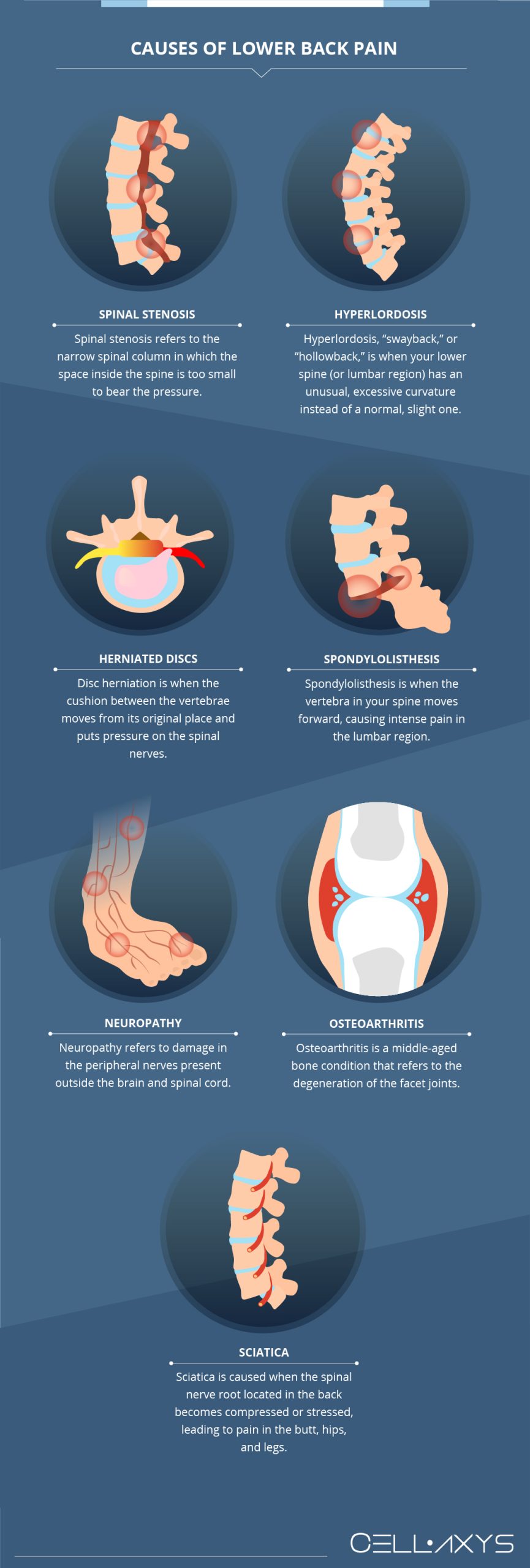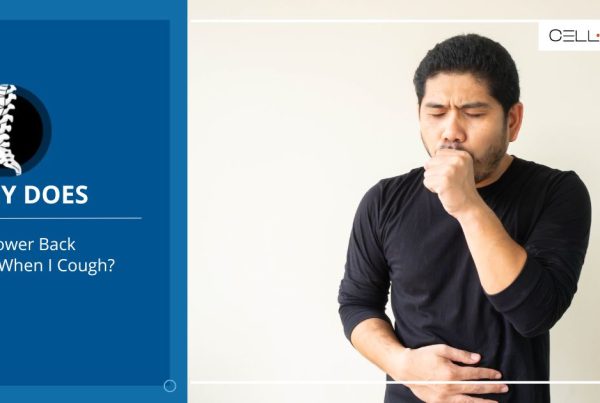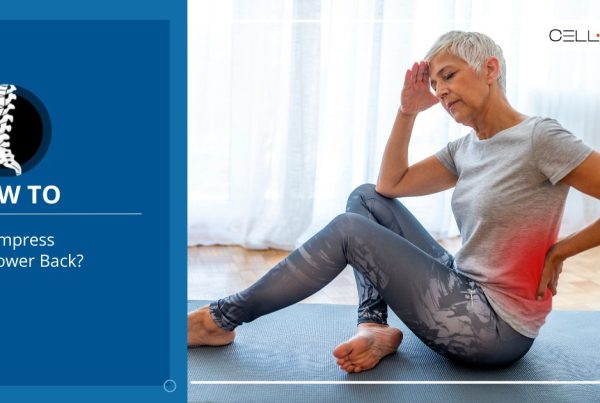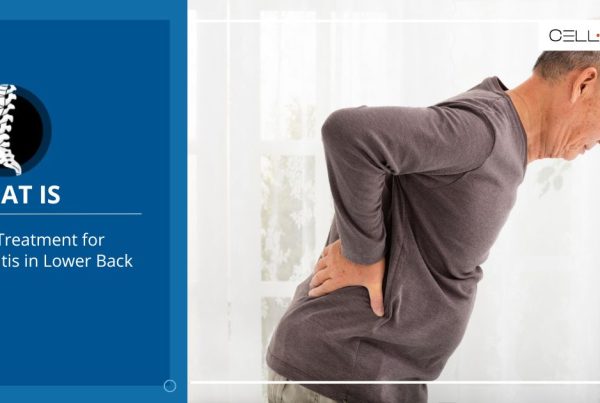Published on: March 6, 2024 | Updated on: September 4, 2024
Contrary to popular opinion, back pain doesn’t just result from bad lifestyle habits. Instead, it can also arise from postural stress or any condition that makes your body balance the pressure on the lower back by pushing it backwards on the pelvis.
In some situations, lower back pain also results from serious underlying issues like spinal stenosis, hyperlordosis, or herniated discs.
Many people feel discomfort and swelling in the lower area when standing for extended periods. Excessive stress around the spine tightens the muscles in your lower back, causing spinal nerves and joint pain.
The ideal treatments for lower back pain when standing are stretching, resting, and sleeping on a posture-supportive mattress. If they don’t help, the doctor recommends regenerative medicine methods like cell-based or platelet-rich plasma (PRP) therapies.
Major Causes of Lower Back Pain When Standing

The most common causes of lower back pain are muscle strains, sprains, or fatigue. Sometimes, it is due to an accident or injury. Other times, it could be overexertion, overstretching, or unusual twisting of the tendon.
Here are possible reasons for lower back pain due to prolonged standing:
Spinal Stenosis
Spinal stenosis refers to the narrow spinal column in which the space inside the spine is too small to bear the pressure. This stresses the spinal nerves and spinal cord, causing intense neck and lower back pain.
Hyperlordosis
Hyperlordosis, “swayback,” or “hollowback,” is when your lower spine (or lumbar region) has an unusual, excessive curvature instead of a normal, slight one. This shifts strain to the anterior direction, leading to lower back pain when standing for prolonged periods.
Herniated Discs
Disc herniation is when the cushion between the vertebrae moves from its original place and puts pressure on the spinal nerves. The slipped-out discs cause intense lower back pain when standing.
Spondylolisthesis
Spondylolisthesis is when the vertebra in your spine moves forward, causing intense pain in the lumbar region. This condition can occur in any part of the spine, but the lower back is most likely affected.
Neuropathy
Neuropathy refers to damage in the peripheral nerves present outside the brain and spinal cord. It can cause numbness and pain in any part of your body, but the hands, feet, and lower back are the main affected areas. Peripheral neuropathy can disrupt your body’s functions, like excretion and digestion.
Osteoarthritis
Osteoarthritis is a middle-aged bone condition that refers to the degeneration of the facet joints. Over time, our body loses cartilage, making the bones prone to breakage and painful stiffness. Osteoarthritis can affect the hip, thumb, knee joints, and lower back.
Sciatica
Sciatica is caused when the spinal nerve root located in the back becomes compressed or stressed, leading to pain in the butt, hips, and legs. This condition usually occurs from the degeneration of one or more intervertebral discs.
Lifestyle Habits Leading to Lower Back Pain
Our lifestyle habits also contribute a lot to the low back pain. If you’re following any of the below things, you’re more likely to suffer from this discomfort when standing.
- Insufficient daily exercises or movements
- Doing the wrong exercises, especially sit-ups
- Maintaining a poor posture that results in improper weight distribution
- Wearing painful or non-supportive shoes
- Sleeping on a poor mattress
- Lifting heavy objects
- Having an unhealthy diet that contributes to overweight or obesity
You can quickly improve some of these habits, but others may require a professional’s help. For instance, you can buy a new mattress to improve your posture. However, you will need an expert physical therapist to find the best shoes or orthotics.
Treatment for Lower Back Pain
Most types of lower back pain can be treated with at-home treatments. However, some factors require advanced methods to get better, i.e., cell-based therapies and PRP therapy.
Conventional Methods
Your doctor will first recommend the following methods to treat your lower back pain:
- Rest. When feeling intense lower back pain when standing, you must first sit down to relieve the excessive stress from your spine. It will minimize the pain quite a lot.
- Nonsteroidal Anti-Inflammatory Drugs (NSAIDs). Some over-the-counter medications like naproxen (Aleve) and ibuprofen (Motrin, Advil) can also help relieve lower back pain.
- Exercise. The doctor will suggest a professional physical therapist for your lower back pain. Some activities, such as sit-ups and toe touches, can worsen your pain. However, hamstring stretches and proper posture maintenance may help reduce the discomfort.
- Orthotics. You may also need proper footwear and shoe inserts to support your feet position and, thereby, lower back.
- Heat and Ice Packs. Regular use of ice or heat packs on your lower back can also minimize the pain within a few minutes. You can repeat this multiple times a day or whenever you feel the pain.
- Weight Loss. You must lose excessive weight to relieve stress on your lower back.
- Massage. Your doctor may also recommend relaxation massages to identify and target areas causing the pain.
- Acupuncture. Acupuncture involves using needles in the areas causing inflammation or pain in the lower back.
Orthobiologic Methods
CELLAXYS offers two types of regenerative medicine treatments for lower back pain: cell-based therapies or platelet-rich plasma (PRP) therapy. Both these methods are ideal for improving lower back pain when standing.
Depending on your lower back’s condition, your surgeon may opt for any of the two procedures:
- Cell-Based Therapies. In this procedure, the doctor extracts healthy cells from the patient’s body, processes them, and reinjects them into the injury site. When the cells are harvested from the adipose tissues, the process is called Minimally Manipulated Adipose Tissue Transplant (MMAT). If they are taken from the bone marrow, the method is known as Bone Marrow Concentrate (BMAC).
- Platelet-Rich Plasma (PRP) Therapy. In PRP, the surgeon takes the patient’s blood plasma, isolates platelets, processes them, and reinjects them into the injury site. Platelets are the healing components of our body, which perform three main functions. They release 10 growth factors, attract healing cells from the blood, and produce a web-like scaffolding called fibrin. A high number of platelets in the injury site means early chances of recovery.
Cell-based therapies take about 1.5 to 2 hours to complete, while PRP requires 45 minutes. Both are outpatient procedures, meaning you can go home a few hours after the treatment. Patients who have undergone orthobiologic methods at CELLAXYS report quick healing from their back injury.
CELLAXYS does not offer Stem Cell Therapy as a cure for any medical condition. No statements or treatments presented by Cellaxys have been evaluated or approved by the Food and Drug Administration (FDA). This site contains no medical advice. All statements and opinions are provided for educational and informational purposes only.
Dr Pouya Mohajer
Author
Pouya Mohajer, M.D. is the Director of Spine and Interventional Medicine for CELLAXYS: Age, Regenerative, and Interventional Medicine Centers. He has over 20 years of experience in pain management, perioperative medicine, and anesthesiology. Dr. Mohajer founded and is the Medical Director of Southern Nevada Pain Specialists and PRIMMED Clinics. He has dedicated his career to surgical innovation and scientific advancement. More about the doctor on this page.
Dr Pejman Bady
Contributor
Dr. Pejman Bady began his career over 20 years ago in Family/Emergency Medicine, working in fast-paced emergency departments in Nevada and Kansas. He has served the people of Las Vegas as a physician for over two decades. Throughout this time, he has been met with much acclaim and is now the head of Emergency Medical Services in Nye County, Nevada. More about the doctor on this page.









